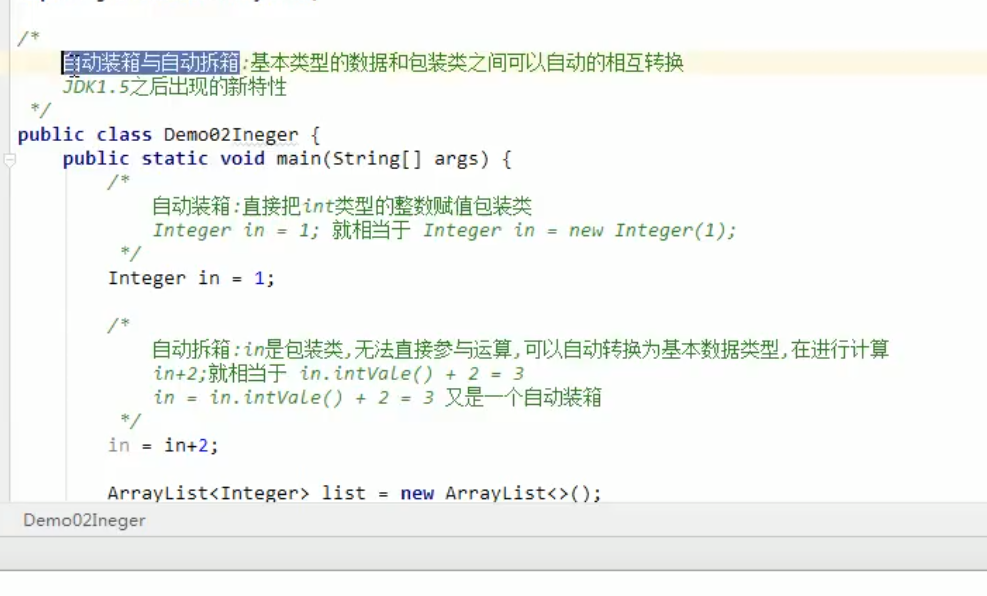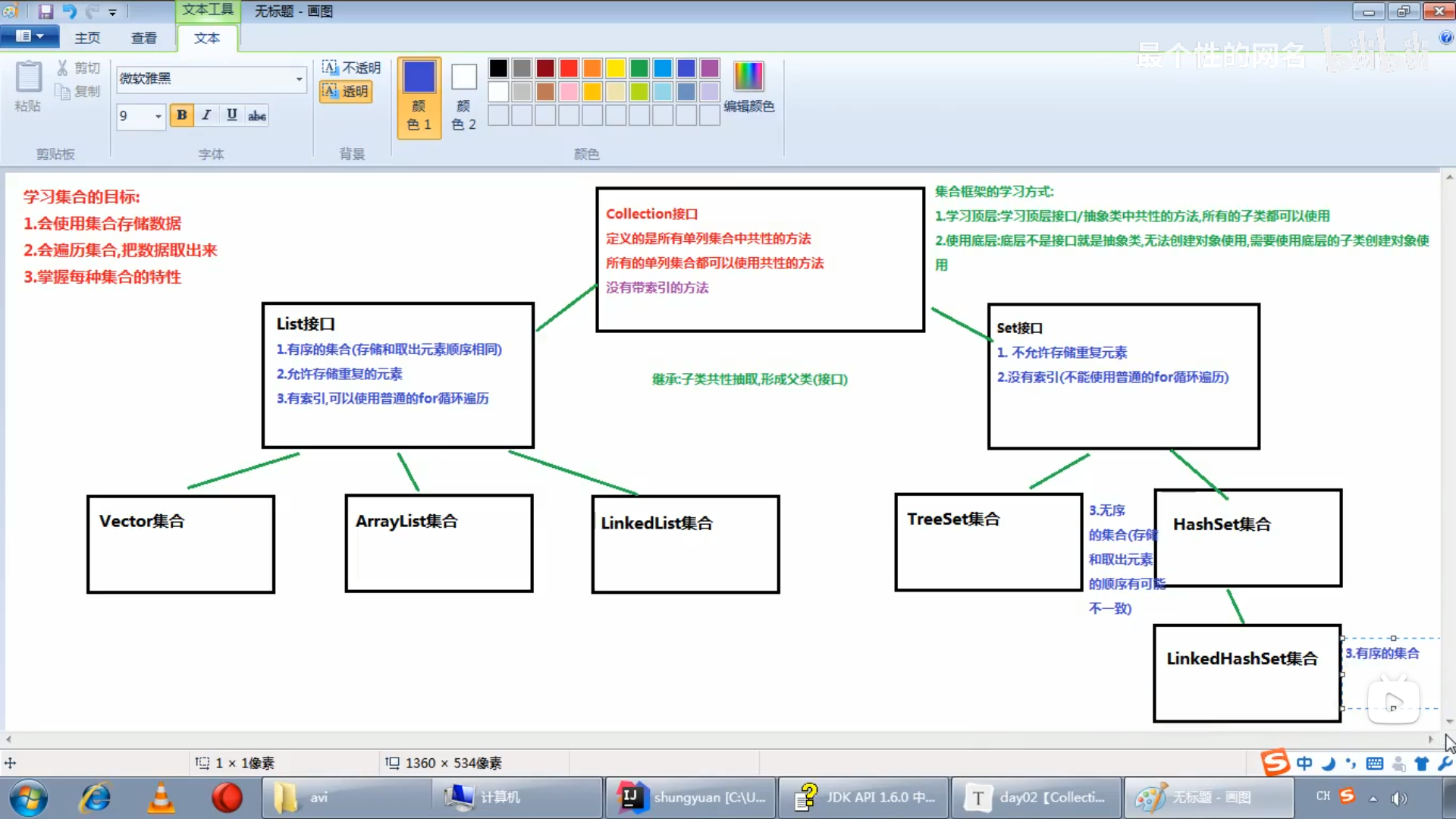- (1):public lang.System 类提供了大量的静态方法,可以获取与系统相关的信息或系统级操作,在System类的API文档中,常用的方法有:
- public static long currentTimeMills():返回以毫秒为单位的当前时间(判断程序跑了多长时间)
- (2):将指定数组中指定数据拷贝到另一个数组中。
- System.arraycopy (src,srcPos0,dest,destPos0,length3)
- (3):StringBuilder字符串缓冲区,可以提高字符串的操作效率,底层也是一个数组,但是没有被final修饰,可以改变长度 (添加字符串)
- byte[] value = new beye[16];
- String str = “Hello”;
- System.out.println(“str”+ str);
- StringBuilder bu = new StringBuilder(str);
- _//往StringBuilder 中添加数据
_bu.append(“World”); - System.out.println(“bu” +bu);
- String s = bu.toString();
- System.out.println( “s”+s);
- (5):装箱和拆箱的概念:装箱:把基本类型的数据,包装到包装类中(基本类型的数据 ->包装类)
- 静态方法:
- 拆箱: 在包装方法中取出的基本类型的数据(包装类 -> 基本类型的数据)
- collection.add(“李四”);
- //collection.clear();
- System.out.println(collection);
- //boolean b7 = collection.remove(“赵六”);
- System.out.println(“b7 “+ b7);
- //boolean b4 = collection.contains(“李四”);
- System.out.println(“b4” + b4);
- //boolean b6 = collection.isEmpty();
- System.out.println(“b6:” + b6);
- int size = collection.size();
- System.out.println(size);
(1):public lang.System 类提供了大量的静态方法,可以获取与系统相关的信息或系统级操作,在System类的API文档中,常用的方法有:
long start = System.currentTimeMillis();
public static long currentTimeMills():返回以毫秒为单位的当前时间(判断程序跑了多长时间)
(2):将指定数组中指定数据拷贝到另一个数组中。
System.arraycopy (src,srcPos0,dest,destPos0,length3)
int[] src = {1,2,3,4,5,};
int[] dest = {6,7,8,9,10};
System.out.println(“复制前” + Arrays.toString(dest));
//使用方法
System.arraycopy(src,0,dest,0,3);
System.out.println(“复制后” + Arrays.toString(dest));
(3):StringBuilder字符串缓冲区,可以提高字符串的操作效率,底层也是一个数组,但是没有被final修饰,可以改变长度 (添加字符串)
byte[] value = new beye[16];
String类:
字符串是常量;它们的值在创建之后不能改变
字符串的底层是final修饰的数组,不能改变,是一个常量
StringBuilder bu = new StringBuilder();
//链式编译:返回值是一个对象,可以继续调用方法
System.out.println(“abc”.toUpperCase().1toLowerCase().toUpperCase().toLowerCase());
bu.append(“abc”).append(1).append(true).append(8.8).append(“中”);
System.out.println(bu);
(4):String 和 StringBuilder 可以相互转换:
String ->StringBuilder :可以使用StringBuilder 构造方法
StringBuilder (String str )构造一个字符串生成器,并转化为指定的字符内容
StringBuilder ->String :可以使用 StringBuilder 中的toString方法
public String toString():将当前StringBuilder 对象转换为String 对象
String str = “Hello”;
System.out.println(“str”+ str);
StringBuilder bu = new StringBuilder(str);
_//往StringBuilder 中添加数据
_bu.append(“World”);
System.out.println(“bu” +bu);
String s = bu.toString();
System.out.println( “s”+s);
(5):装箱和拆箱的概念:装箱:把基本类型的数据,包装到包装类中(基本类型的数据 ->包装类)
构造方法:
Integer(int value) 构造一个新分配的Integer 对象,它表示指定的int 值
Integer(Sring s) 构造一个新分配的Integer 对象,它表示String 参数所指示的int 值
传递的字符串,必须是基础类型的字符串,否则就会抛出异常“100”正确 “0”异常
静态方法:
Static Integer valueof(int i ) 返回一个表示指定的 int 值的 Integer 实例
Static Integer valueof(String s ) 返回保存指定的String 的值 Integer 对象
拆箱: 在包装方法中取出的基本类型的数据(包装类 -> 基本类型的数据)
成员方法:
int intValue() 以 int 类型返回该 Integer 的值
基本数据类型 ->包装对象 : Integer i = new Integer(4);
Integer iii = Integer.valueof(4);
包装对象 -> 基本数据类型 : int num = i.intValue();
(6):基础类型与字符串类型之间的转换:
基础类型 ->字符串
1.基础类型的值+ 最简单的方法
2.包装类的静态方法toString(参数)不是Object类的toString()重载
static String toString (int i )返回一个表示指定整数的 String 对象
3.String 的静态方法 valueof(参数)
static String valueof(int i )返回 int 参数的字符串表示形式
字符串 -> 基础类型
使用包装类的静态方法,parsXXX(字符串)
Integer 类 :static int parseInt(String s)
Double 类:static double parseDoule(String s)
int i1 = 100;
String s1 = i1+””;
System.out.println(s1+200);
String s2 = Integer.toString(100);
System.out.println(s2 + 200);
String s3 = String.valueOf(100);
System.out.println(s3 + 200);
int i = Integer.parseInt(s1);
System.out.println(i-10)
(7): Collection 接口
使用方法:Collection
System.out.println(collection);//重写了toString 方法。
public boolean add(E,e):把给定的对象添加到当前集合中,返回值一般是一个boolean值,一般都是TRue,所以可以不用接受
collection.add(“李四”);
//collection.clear();
System.out.println(collection);
public void clear():清空集合中所有的元素
//boolean b7 = collection.remove(“赵六”);
System.out.println(“b7 “+ b7);
public boolean ramove(E,e):把给定的对象在当前集合中删除,返回值是一个boolean值,删除存在的元素,删除不存在的元素会删除失败,并返回False
//boolean b4 = collection.contains(“李四”);
System.out.println(“b4” + b4);
public boolean contains(E,e):判断当前集合中是否包含给定的对象
//boolean b6 = collection.isEmpty();
System.out.println(“b6:” + b6);
public boolean isEmpty():判断当前集合是否为空,为空返回TRue,不为空返回FAlse
int size = collection.size();
System.out.println(size);
public int size():返回集合中元素的个数
//Object[] arr = collection.toArray();
for (int i = 0; i < arr.length; i++) {
System.out.println(arr[i]);
}
public Object[ ] toArray():把集合中的元素,存储到数组中

